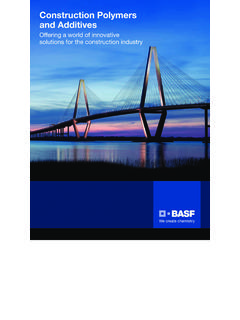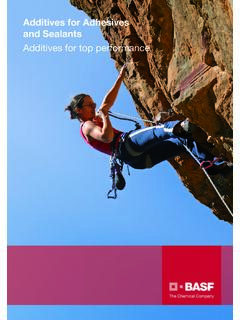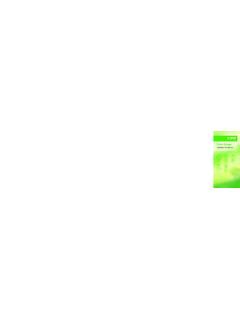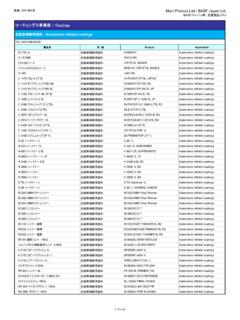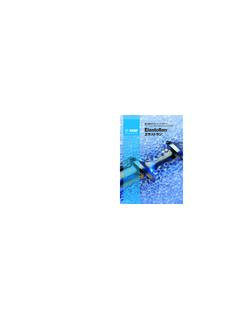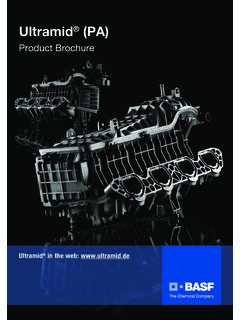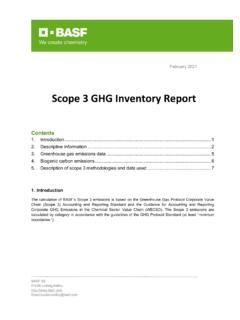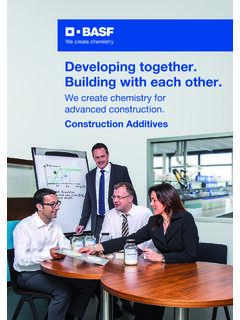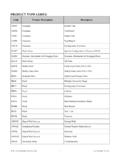Transcription of NFPA 285 Compliant Wall Systems and Assemblies - BASF
1 NFPA 285 Compliant Wall Systems and Assemblies 2. Solutions for Non-combustible Construction Creating non-combustible exterior wall Assemblies has become increasingly challenging as building design has evolved toward greater levels of energy efficiency. To meet the requirements of the International Energy Conservation Code, buildings have incorporated air/water-resistive barriers on exterior sheathing and CMU walls, together with extensive use of exterior insulation. In addition to improving energy efficiency, these changes can provide effective moisture management by incorporating an airtight secondary drainage plane, and by moving the dew point of the wall assembly outside of the drainage plane. 3. However, both the air/water-resistive barrier and many types of exterior insulation are made from organic materials that are combustible.
2 One challenge for design professionals is to incorporate combustible materials into noncombustible construction in a way that reliably provides the fire performance required by the International Building Code. Finestone Pebbletex CI-DCA, Pebbletex CI-DCA with MaxGrip Veneer Mortar, Pebbletex Platinum CI and Platinum CI Stucco Ultra Wall Systems have been comprehensively qualified for use in non- combustible construction. When installed per basf details and instructions, they provide code- Compliant fire performance as listed on system brochures. This extensive set of performance data is steadily updated as local and national fire standards evolve. Finestone Wall Systems provide code Compliant performance. 4. Finestone specialty finishes are available in brick, stone, metal, and stucco motifs. Dynamic aesthetics combined with continuous exterior insulation and a monolithic air/water-resistive barrier create impressive lightweight, high-performance building enclosures.
3 Wall Assemblies Wall Assemblies are a collection of products from more than one manufacturer that collectively function as a wall cladding. Insulation, exterior skin, air barrier, water-resistive barrier, fasteners, lintels, furring and other components come together to form a wall assembly. FINESTOP air/water-resistive barriers are fluid-applied Systems that are supported with ICC-ESR 2986, which confirms code compliance in Type I V construction. FINESTOP Systems can be used to create a continuous drainage plane and air barrier system as part of a wall assembly design. Finestone CI Wall Systems Finestone CI Wall Systems presented in this guide incorporate a FINESTOP air/water-resistive barrier, continuous exterior insulation and an outer skin that can be finished to create a broad range of appearances. These Systems meet the full range of International Building Code and International Energy Conservation Code requirements, and are supported with third-party test data, architectural details and system warranties.
4 Utilizing Finestone CI Wall Systems provides a simplified approach to wall cladding design. 5. Solutions for Buildings with Multiple Claddings Where buildings employ multiple claddings, FINESTOP air/water-resistive barriers can be extended beyond Finestone wall Systems , and provide NFPA 285 Compliant performance as part of wall Assemblies that utilize materials from multiple manufacturers. Although not related to fire performance, airtightness and secondary water drainage are key building considerations. Use of a continuous, monolithic air/water-resistive barrier, supplied by a single manufacturer, is a recognized way to improve air tightness and moisture management. It also helps integrate multiple cladding Assemblies into an overall building enclosure. FINESTOP RA, FINESTOP RS, and FINESTOP VB. are supported with extensive NFPA 285 data covering a wide range of wall assembly options.
5 This allows design professionals to specify FINESTOP products behind multiple claddings used alone or in conjunction with Finestone Wall Systems . Claddings that are comprised of materials Finestop air/water-resistive barriers can provide a continuous from more than one manufacturer require careful air and water-resistive barrier behind multiple claddings for uninterrupted air and moisture protection consideration. Some fire requirements, such as the ASTM E84 Steiner Tunnel test, apply to specific materials. Others, such as NFPA 285, are assembly tests where the assembly itself must be evaluated. NFPA 285 Compliant Wall Systems and Assemblies The components listed in the following sections Base Wall System (Section A), Air/Water-Resistive Barrier (Section B), Exterior Insulation (Section C), and Exterior Cladding (Section D) can be combined to create wall Systems and Assemblies that comply with NFPA 285 requirements.
6 6. SECTION A: Base Wall System 1. Concrete Wall 2. Concrete Masonry Wall 3. Steel Stud Framed Wall: a. Interior wallboard: minimum 1 layer of 1/2 or 5/8-inch Type X. Minimum 20-gauge 3-5/8 inch studs, with lateral bracing gypsum wallboard on interior face of studs every 4 feet vertically (maximum 24 ) b. Interior vapor barrier (optional) 1 layer of maximum 6-mil polyethylene plastic c. Cavity insulation: None or any noncombustible insulation (faced or unfaced). d. Floorline firestopping: 4 lb/cu foot mineral wool ( Thermafiber ). in each stud cavity and at each floorline, attached with Z-clips or equivalent e. Exterior sheathing: 1/2-inch or 5/8-inch thick exterior grade gypsum sheathing 4. Podium Wall: a. Interior wallboard: minimum 1 layer of 1/2-inch or 5/8-inch Type X. 3-5/8 inch Fire Retardant Treated (FRT) lumber studs, gypsum wallboard on interior face of studs spaced 16 or 24 , with lateral bracing every 4 feet b.
7 Interior vapor barrier (optional) 1 layer of maximum 6-mil vertically (maximum 24 ) Openings may be lined with polyethylene plastic FRT lumber. c. Cavity insulation: None or any noncombustible insulation NOTE: Qualified for use with Finestone CI and CI (faced or unfaced). Stucco Systems only. d. Floorline firestopping: 4 lb/cu foot mineral wool ( Thermafiber ). in each stud cavity and at each floorline, attached with Z-clips or equivalent e. Exterior sheathing: 1/2-inch or 5/8-inch thick exterior grade gypsum sheathing; FRT Plywood or LP Flameblock (2-sided). SECTION B: Air/Water-Resistive Barrier 1. Finestop RA or Finestop RS With 4 basf SHEATHING FABRIC reinforcement or 20-mils basf . Vapor permeable barriers MAXFLASH Liquid Flashing Membrane at sheathing joints 2. Finestop VB With 4 basf SHEATHING FABRIC reinforcement or 20-mils basf .
8 Class 1 vapor retarder MAXFLASH Liquid Flashing Membrane at sheathing joints SECTION C: Exterior Insulation Selections for Wall Assemblies with Finestop Air/Water- Resistive Barriers 1. None 2. Any unfaced noncombustible insulation ( mineral wool). 3. Expanded Polystyrene Foam (EPS) a. Maximum basf NEOPOR GPS Plus Type II Rigid Insulation Board b. Maximum thickness ASTM C578 Type II EPS. (must be ASTM E84 Class A). c. Maximum thickness ASTM C578 Type IX EPS. (must be ASTM E84 Class A). 4. Extruded Polystyrene Foam (XPS) Maximum 3-inch thickness, ASTM C578 Type IV or Type X. (must be ASTM E84 Class A). 5. Polyisocyanurate Foam a. Maximum 4-inch thickness, Atlas EnergyShield Pro b. Maximum 4-inch thickness, Atlas EnergyShield Pro2. c. Maximum 3-1/2-inch thickness, Hunter Xci Class A. d. Maximum 3-1/2-inch thickness, Hunter Xci CG.
9 E. Maximum 4-1/4-inch thickness, Hunter Xci Ply (maximum 3-1/2-inch thickness foam, maximum 3/4 inch plywood). f. Maximum 3-1/2-inch thickness, Carlisle R-2+ Sheathe, R2+ Mat or R2+ Silver 7. SECTION D: Finestone Exterior Cladding Systems 1. Pebbletex CI-DCA a. Maximum 12-inch thickness ASTM C578 Type I EPS (must be ASTM E84)*. b. Maximum 4-inch thickness ASTM C578 Type I EPS (must be ASTM E84)* with MAXGRIP VENEER MORTAR and adhered veneer (eg. thin brick, stone, tile). * EPS insulation used in Pebbletex CI-DCA must meet Finestone specifications 2. Platinum CI a. Maximum 12-inch thickness NEOPOR GPS Type I Rigid Insulation Board b. Maximum thickness NEOPOR GPS PLUS Type II Rigid Insulation Board*. * Neopor insulation used in Platinum CI must meet Finestone specifications 3. Platinum CI Stucco Ultra a. Maximum thickness of ASTM C578 Type II EPS (must be ASTM E84.)
10 Class A). b. Maximum thickness NEOPOR GPS PLUS Type II Rigid Insulation Board c. Maximum 3-inch thickness of ASTM C578 Type XI EPS (must be ASTM E84. Class A). d. Maximum thickness of ASTM C578 Type IX EPS (must be ASTM E84. Class A). e. Maximum 3-inch thickness XPS, ASTM C578 Type IV or Type X (must be ASTM E84 Class A). f. Maximum 3-inch thickness, Atlas EnergyShield Pro g. Maximum 3-inch thickness, Atlas EnergyShield Pro2. h. Maximum 3-inch thickness, Hunter Xci Class A. i. Maximum 3-inch thickness, Hunter Xci CG. j. Maximum 4-1/4-inch thickness, Hunter Xci Ply (maximum 3-1/2-inch foam, maximum 3/4-inch plywood). k. Maximum 3-inch thickness, Carlisle R-2+ Sheathe, R2+ Mat or R2+ Silver NOTE: Interior sheathing must be 5/8" type X gypsum wallboard for all CI Stucco Systems 8. SECTION D: Exterior Cladding Wall Assemblies using Finestop Air/Water-Resistive Barriers 3.
